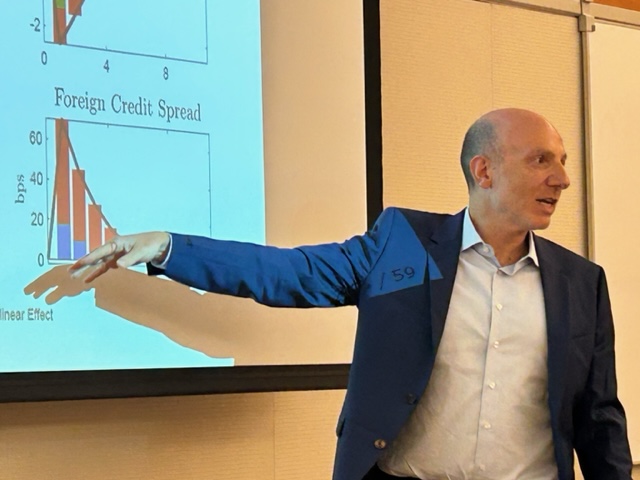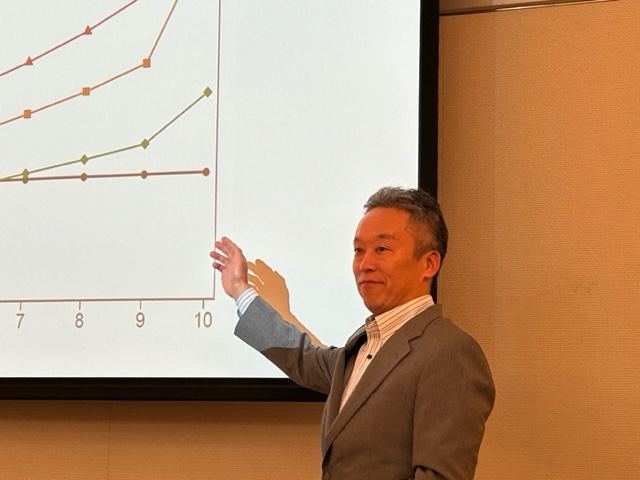On August 24, 2023, the Institute for Monetary and Economic Studies of the Bank of Japan (BOJ) participated in a joint workshop with the Bank of Canada (BoC) and the Federal Reserve Bank of Philadelphia (Philadelphia Fed), at the Philadelphia Fed.
The workshop was initiated by the BoC and the BOJ in 2013, and the Philadelphia Fed joined in 2019. This year’s workshop was the sixth workshop, and two external speakers were invited: Dr. Matteo Iacoviello (Federal Reserve Board), and Professor Gauti Eggertsson (Brown University).
This newsletter summarizes four papers on monetary policy from among the papers presented.[1]
1. Labor Market and Monetary Policy

Dr. Kurt See (BoC) presented his research on the impact of job-to-job transitions on inflation. (The title of the paper is “Labor Market Shocks and Monetary Policy.”)
In textbook macroeconomics, when the unemployment rate falls, the inflation rate should rise. This relationship is what is often referred to as the “Phillips curve.” In reality, however, even when the unemployment rate falls significantly, the inflation rate may not rise as much, as seen, for example, over several years in the United States prior to the pandemic.
Under normal circumstances, when the unemployment rate falls, the job-to-job transition rate tends to rise. However, during this period, the rise was limited. Dr. See and his co-authors focus on this point and show theoretically that low job-to-job transition could contain a rise in the inflation rate. In other words, when considering changing jobs, workers compare the wages they earn from their current job with the wages they will earn from their next job and change jobs if the latter is higher. However, even if the worker does not ultimately change jobs, from the employer's perspective, a worker who is offered a higher wage by a potential new employer is at risk of changing jobs in the future, which in the model leads to the renegotiation of wages between the worker and the employer. If the current employer offers a higher wage, wages will rise, resulting in a higher inflation rate.
Their analysis underscores the importance of a decline in job mobility in explaining the so-called “missing inflation” in 2016-2019 when the unemployment rate was extremely low. It suggests that if job mobility had remained at the same level as before, the inflation rate might have risen by about 25 basis points over the actual figure.
2. Non-Linearity in the Phillips Curve

In the U.S., the labor market is tightening, and inflation is rising. Professor Eggertsson presented an analysis on the possibility of a sharp and significant increase in the inflation rate triggered by exceptional tightening of the labor market, i.e., non-linearity in the Phillips curve. (The title of the paper is “It’s Baaack: The Surge in Inflation in the 2020s and the Return of the Non-Linear Phillips Curve.”)
The analysis focuses on the variable v/u; that is, job vacancies divided by unemployed workers. This variable is expected to rise when the labor market tightens, because the number of job openings rises and the number of unemployed falls.
Examining the development of v/u for the U.S. from 1960 to 2022, the analysis shows that in periods when v/u exceeds unity, further tightening of the labor market tends to result in a more significant increase in the inflation rate than in other periods. This observation suggests the presence of a non-linear relationship with a threshold of 1. Indeed, this non-linear relationship between the inflation rate and v/u is also confirmed by econometric models.
Using a model with search and matching frictions and downward nominal wage rigidity, the analysis also provides a theoretical background for the non-linearity. Specifically, when there are more job vacancies than unemployed workers (v/u>1), firms may offer higher wages to attract employees, leading to an increase in wages. By contrast, when job vacancies are less than the number of unemployed workers (v/u<1), firms would not be able to cut wages to newly hire workers because employees do not accept a cut in wages. When wages are set like this, inflation rates should exhibit non-linearity.
Based on these arguments, Professor Eggertsson and his co-author point out that the recent surge in the inflation rate in the United States may be caused by tightening labor markets, and that GDP growth may not be sacrificed much to contain the inflation rate.
3. Synchronization in Monetary Policy and its International Propagation

Currently, many jurisdictions, including the U.S. and Europe, are seeing an upsurge in inflation rates, and their policy rates are on the rise. Theoretically speaking, a rise in the policy rate in one country is considered to suppress aggregate demand and contain inflationary pressure in the country; but with economic activities becoming more interconnected globally than before, it can also affect other countries.
The research which Dr. Iacoviello presented examines the mechanism from both empirical and theoretical perspectives (the title of the paper is “The International Spillovers of Synchronous Monetary Tightening”). He and his co-authors use the data for 21 advanced economies from 1980 to 2019 and examine the impact on a country when it raises its policy rates while other countries are doing likewise with the case where other countries do not raise their policy rates. They show that a hike in the policy rate in a country reduces the country's real GDP growth greater in the former case than in the latter.
They focus on the role played by cross-border lending by global financial institutions and consider an economy where a firm raises funds from both domestic and foreign financial institutions. A rise in the domestic policy interest rate dampens the economic activity through higher domestic lending rates. But the effects are attenuated if the firm can borrow funds from other countries. In other words, the adverse effect of the domestic policy rate hike becomes larger when both domestic and foreign countries simultaneously raise their policy rates.
Because financial transactions are larger in amount, more global in structure, more subject to rapid technological innovation and environmental changes than real transactions, it is necessary to keep an eye on their impact on monetary policy transmission.
4. Household Income in Canada and Monetary Policy

Dr. Yasuo Terajima (BoC) presented his research on the relationship between household income distribution and GDP, and the impact of monetary policy on the household income distribution, using Canadian tax data. (The title of the paper is “Canadian Income Inequality and Monetary Policy.”)
The impact of monetary policy on household income distribution is an area of great interest in macroeconomics, and there are already studies for countries including the U.S., Europe, and Japan. At present, however, there is no consensus, with views such as that monetary policy tightening widens income inequality by for example increasing unemployment, or alternatively, that it reduces income inequality by reducing the capital income of high-income households. One reason for this lack of consensus is that there are many factors that influence household income distribution, such as economic policy, the business cycle, and social and economic structures.
Dr. Terajima’s analysis uses comprehensive income tax data in Canada from 1982 to 2019. He reports the following results, though pointing out that they are tentative. First, regarding the relationship between GDP growth and household income distribution, when GDP increases, the distribution becomes more right-skewed in addition to the increase in mean. In other words, as the economy expands, the income distribution does not shift to the right in the same shape, but the extremely high-income households tend to increase more. Second, regarding the relationship between monetary policy and household groups with different income levels, tightening monetary policies reduces the income of high-income households greater than that of low-income households. In other words, monetary policy tightening reduces income inequality.
Analysis using the granular data of households’ income is extremely important for understanding the nature of inequality, but also for deepening our understanding of the transmission mechanism of monetary policy as it provides insights into how each household reacts differently to monetary policy and what factors contribute to these differences.
Notes
- In addition to the papers summarized here, from the Philadelphia Fed, Dr. Enghin Atalay presented a paper titled “Gender Targeting in the U.S. Newspaper Ads: 1940-2000,” and Dr. Wenli Li presented a paper titled “The Great Reshuffle: Residential Sorting During the COVID-19 Pandemic and Its Welfare Implications.” From the BOJ, Dr. Nao Sudo presented a paper titled “Effects of Monetary Policy Shocks on Inequality in Japan,” and Mr. Yasutaka Ogawa presented a paper titled “Aging, Homeownership, and Macroeconomic Inefficiency.” [1]
